#amulets and superstitions
Text

24 notes
·
View notes
Text
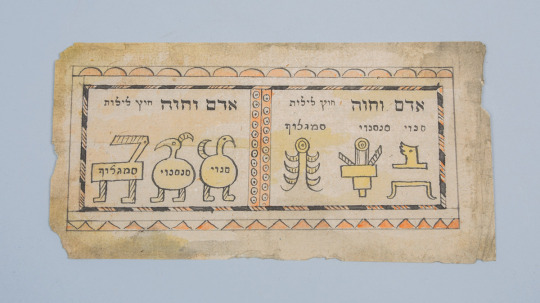
Amulet (“kame’a”) against difficult childbirth. Beshenkovichi, Vitebsk Province, Belarus. Late 19th century.
The text is repeated twice, in the left and right part of the amulet: “Adam and Eve. To expel Lilith, Senoi, Sansenoi, Sammangelof.” The image and text are reproduced after “Raziel,” a mystic 11th century book that served as a kind of instruction for making amulets.
334 notes
·
View notes
Text

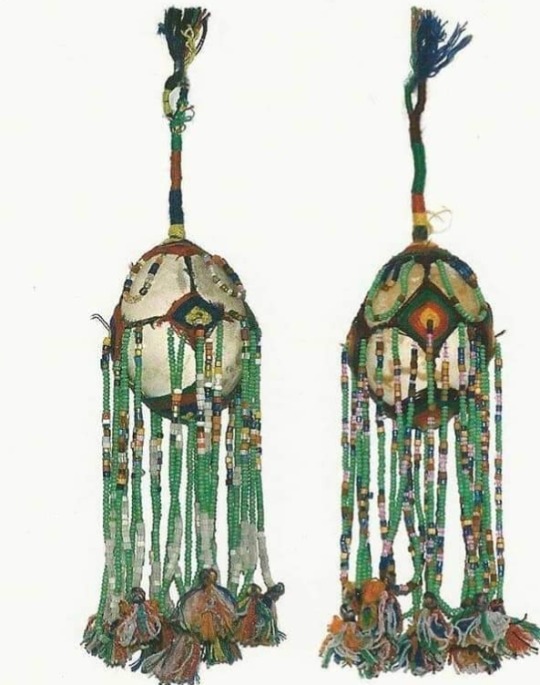
Egg amulets by Varsenik Hayrapetyan (b. 1903,Stepanakert).
#these are actual eggs if i understood it correctly#armenia#armenian#armenianblog#armenian art#superstition#amulet#evil eye#armenian culture#artsakh
171 notes
·
View notes
Text
Ancient superstitions are so ingrained in our shared psyche that even those of us who no longer believe in them often find ourselves following them. Dive into the eerie tapestry of ancient superstitions, where fear and fascination wove the fabric of history.
#superstitions#myths#evil eye#misfortune#bad luck#amulets#mythology#traditions#ancient#history#ancient origins
25 notes
·
View notes
Text
I've been struggling really hard with a fatigue/insomnia cycle lately. The other day I made myself leave the house and I put on my favorite bracelet, full of nazar beads. For the past 3 nights I've worn it, I've slept through the night and been functional the next day. I know it's superstitious, obviously, but I think it might be protecting me from the evil eye or bad intentions of my upstairs neighbor, who very much has it out for me right now. I might add my hamsa necklace to the mix. Whatever helps me sleep at night, right? 😉
2 notes
·
View notes
Text
lying on my stomach, kicking my feet up in the air, smiling at my computer, you look at the monitor and i;m staring at osteoarchaeology and strontium
#my posts#this is so silly but today I've been reminded by how insane archaeology is#like I was looking up things about magic medieval deer for my thesis#(if anyone is curious perforated antler tines appear all the time at early med settlements and while they might just be waste#im going to try and argue possibly amulets because penitentials mention hunt rituals and other superstitions include burying in deer skin e#) and i was reminded how the antlers used in the abbots bromley horn dance were radiocarbon dated to the 11th c#adn now (becasue im sorry i have a franklin expedition obsession every 6 months) I was reading recent articles about the recovered bodies#and how a mix of strontium analysis and facial reconstruction has been able to identify two of the individauls' remains#its absolutely insane also they're finding hair in the waterlogged ships?? i can't wait for reports to start being published#ahhh just!! i could never do science archaeology it but i want to kiss every science-side archaeologist#thank you for your service and finding such cool cool things which I can read about!!!
0 notes
Text
The Enigmatic Power of the Evil Eye Necklaces
The evil eye symbol, steeped in mystique and cultural significance, has captivated hearts and minds for centuries. Embodied in an evil eye necklace, this ancient symbol not only adds a touch of style to your ensemble but also serves as a powerful talisman of protection against negative energies. In this comprehensive guide, we will delve into the fascinating world of evil eye necklaces, exploring…

View On WordPress
#cultural significance#evil eye necklace#eye amulet#folklore#Jewelry#mystical#protection#superstition#Symbolism#talisman
0 notes
Text
The Ultimate Grimoire Guide
So! I have been seeing a ton of grimoire ideas and thought I’d stuff them all together. A lot of ideas are from @manifestationsofasort, @banebite, and @pigeonflavouredcake. Check them out! They have a ton of cool stuff there.
What Do I Use For My Grimoire?
You can use anything for a grimoire! For a physical one, journals, binders, and notebooks are good. For digital ones, Notion, Tumblr, Docs, and even just your file folder are great.
Introduction
A Book Blessing
Table of Contents
About Me
Your Current Path
Your Personal Beliefs
Your Spiritual Journey
Superstitions
Past lives
Favorite Herbs/Crystals/Animals/Etc.
Natal Chart
Craft Name
How You Entered The Craft
Astrology Signs
Birthday Correspondences (birth tarot card, birth stone, etc.)
Goals
Safety
Fire Safety
What Not to Burn
Toxic Plants & Oils (to humans, plants, animals)
Crystals That Shouldn’t Be Put… (in sun, in water, etc.)
Things That Shouldn’t Be In Nature (glass, salt, etc.)
Potion Safety
How to Incorporate Blood in Spells
Smoke Safety
Wound Care
Biohazards
Core Concepts
Intention & How It Works
Directing Energy
Protection
Banishing
Cleansing
Binding
Charging
Shielding
Grounding
Centering
Visualization
Consecration/Blessing
Warding
Enchanting
Manifestation
Meditation
What Makes A Spell Work
Basic Spell Structure
What Not To Do In Spells
Disposing Spell Ingredients
Revitalizing Long Term Spells
How To Cast Spells
What To Put In Spells
Spell Mediums (jars, spoken, candle, sigils)
Spell Timing
Potion Bases
Differentiating Between Magick and Mundane
Common Terms
Common Symbols
Intuition
Elements
Basic Alchemy and Symbols
Ways To Break Spells
Laws and Philosophies
Correspondences
Herbs & Spices
Crystals & Rocks
Colors
Liquids & Drinks
Metals
Numbers
Tarot Cards
Elements
Trees & Woods
Flowers
Days
Months
Seasons
Moon Phases
Zodiacs
Planets
Incense
Teas
Essential Oils
Directions
Animals
Symbology
Bone Correspondences
Different Types of Water
Common Plants
Entities
Deities You Worship
Pantheons
Pantheons & Deities Closed to You
Common Offerings
Epithets
Mythos
Family
Worship vs Work
Prayers & Prayer Template
Altars
Deity Comms
Devotional Acts
Angels
Demons
Ancestors
Spirit Guides
Fae
Familiars
House, Animal, Plant, Etc. Spirits
Folklore Entities
Spirit Etiquette
Graveyard Etiquette
Boundaries
Communication Guide & Etiquette
Spirit Work Safety Guide
How Entities Appear To You
Circle Casting
Common Offerings
Altars
Servitors
Mythological Creatures (dragons, gorgons, etc.)
Utility Pages
Gazing Pages
Sigil Charging Station
Altar Pages
Intent Pages
Getaway Pages
Vision Boards
Dream Pages
Binding Page
Pendulum Board
Crystal Grid
Throwing Bones Page
Divination Pages
Mirror Gazing Page
Invocation Pages
Affirmation/Manifestation Pages
Spirit Board Page
Other Practices
Practices That Are Closed to You (Voodoo, Hoodoo, Santeria, Brujeria, Shamanism, Native Practices)
Wicca and Wiccan Paths
Satanism, Both Theistic and Non-Theistic
Deity Work
Religious Paths (Hellenism, Christianity, Kemeticism, etc.)
Animism
Types of Magic/Spells
Pop Culture Paganism/Magic
Tech Magic
Chaos Magic
Green Magic
Lunar Magic
Solar Magic
Sea Magic
Kitchen Magic
Ceremonial Magic
Hedge Magic
Death Magic
Gray Magic
Eclectic Magic
Elemental Magic
Fae Magic
Spirit Magic
Candle Magic
Crystal Magic
Herbalism
Glamours
Hexes
Jinxes
Curses
Weather Magic
Astral Magic
Shadow Work
Energy Work
Sigils
Art Magic
Knot Magic
Music Magic
Blood Magic
Bath Magic
Affirmations
Divination
Tarot Cards
Oracle Cards
Playing Cards
Card Spreads
Pendulum
Numerology
Scrying
Palmistry
Tasseography
Runes
Shufflemancy
Dice
Bibliomancy
Carromancy
Pyromancy
Psychic Abilities
Astrology
Auras
Lenormand
Sacred Geometry
Angel Numbers
Ornithomancy
Aeromancy
Aleuromancy
Axinomancy
Belomancy
Hydromancy
Lecanomancy
Necromancy
Oneiromancy
Onomancy
Oomancy
Phyllomancy
Psephomancy
Rhabdomancy
Xylomancy
Tools
Crystal grid
Candle grid
Charms
Talismans
Amulets
Taglocks
Wand
Broom
Athame
Boline
Cingulum
Stang
Bells
Drums
Staffs
Chalices
Cauldrons
Witches Ladder
Poppets
Holidays
Yule
Imbolc
Ostara
Beltane
Litha
Lammas
Mabon
Samhain
Esbats
Deity Specific Holidays
Religious Holidays (Christmas, Easter, Dionysia, etc.)
Celestial Events
Altars
Basics of Altars
Travel Altars
Deity Altars
Spirit Altars
Familiar Altars
Ancestor Altars
Self Altars
Working Altars
Self-Care
Burnout Prevention
Aromatherapy
Stress Management
Coping Mechanisms
Theories & History
Witchcraft history
Paganism
New Age Spirituality
Cultural Appropriation
Thelema
Conspiracy Theories
Cults
Satanic Panic
KJV
Witches in History
Cats in History
Transphobia in Witchcraft Circles
Queerness in Witchcraft Circles
Other
Recipes
How to Get Herbs
Foraging
Drying Herbs and Flowers
Chakras
Reiki
Witches Alphabet
Runic Alphabet
Guide to Gardening
Your Witch Tips
Resources
Other Tips
List of Spells
Cryptids and Their Lore
What is a Liminal Space?
#witch#witchblr#baby witch#witchcraft#witches#kitchen witch#witchcore#witch aesthetic#witchery#witches of tumblr#spoonie witch#beginner witch#witch community#moon witch#green witch#pagan witch#witchy#grimoire#bos#book of shadows#grimoire ideas#book of shadows ideas#bos ideas
5K notes
·
View notes
Text
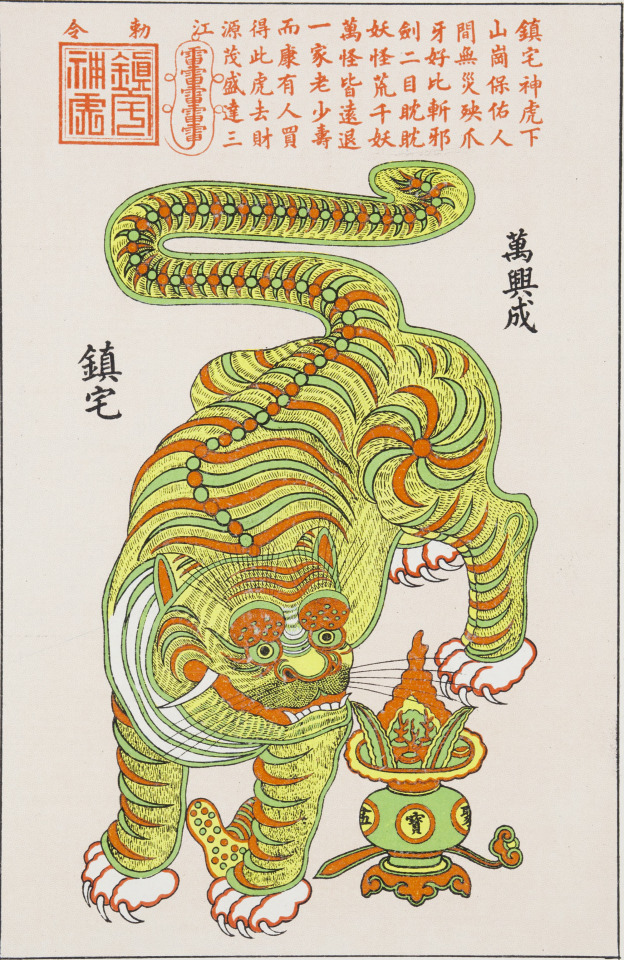
Tiger amulet for guarding hidden treasures. Researches into Chinese superstitions. 1926.
Internet Archive
1K notes
·
View notes
Note
are hamsas a jewish thing? i see them all over jewish sites and in synagogues but i also see gentiles using/wearing them???
Short answer: Yes, hamsas are a Jewish thing, but they're not exclusively Jewish.
An open palm as a symbol is seen throughout the Middle East, and it is given many names and meanings. There is no consensus as to the origin of the symbol, but considering hand prints are seen even in paleolithic art all across the world, it wouldn't be that hard to see how a hand could become such an important symbol.
In Judaism, hands are often featured in artwork as the two hands of the Kohanim during the Priestly Blessing and as references to God's mighty hand when freeing the Jews from Egypt. Hamsas have been used as Jewish amulets since at least the Middle Ages, and there's evidence of hand symbology being used even earlier. The belief in Ayin Hara (The Evil Eye), which is often tied to Hamsas, is also a very old Jewish belief. It, too, is not an exclusively Jewish belief, but rather a belief common among Middle Eastern and Meditteranean cultures.
Not all Jews use the Hamsa as a symbol, and indeed many frown on it, seeing it as a superstition that is best not touched. However, it has been used for a long time by Sephardi and Mizrachi Jews, as well as more Kabbalistic Ashkenazi Jews.
Because of its appearence in both Jewish and Muslim cultures, the hamsa has become a symbol of Judeo-Islamic unity by some people. In 2009, the Hamsa Flag was envisioned as the flag of a united Israeli-Palestinian state.
In conclusion,
RATING: JEWISH (BUT NOT EXCLUSIVELY)
Further reading about Hamsas, Amulets, and the Evil Eye:
Sagiv, Gadi. “Dazzling Blue: Color Symbolism, Kabbalistic Myth, and the Evil Eye in Judaism.” Numen, vol. 64, no. 2/3, 2017, pp. 183–208. JSTOR, http://www.jstor.org/stable/44505334.
SABAR, SHALOM. “From Sacred Symbol to Key Ring: The Ḥamsa in Jewish and Israeli Societies.” Jews at Home: The Domestication of Identity, edited by SIMON J. BRONNER, Liverpool University Press, 2010, pp. 140–62. JSTOR, https://doi.org/10.2307/j.ctv1rmjz2.8.
Hamsa (Aish.com)
Amulets and Talismans (YIVO encyclopedia)
The Hamsa In Jewish Thought and Practice (Times of Israel)
Hamsa Flag (Ayin Press)
353 notes
·
View notes
Note
Hello!
I had a question about my favourite part of the demo so far (Kesha pov <3), Do the amulets that they make have any kind of actually magic/power or is it more just a werewolf superstition thing?
Love the IF and keep up the good work!
It's a bit of both. The amulets have some influence on werewolves, but not a nearly as much as one is made to believe. During full moon, amulets can be blessed, but the Moon is mostly a silent observer, it guides them and comforts. It makes its werewolves feel home.
But it cannot heal them, it can't offer material help, it can't offer them strength.
However, because werewolves are so superstitious, the amulets work intrinsically because they believe in them. Just holding one is enough to pacify them or give them the strength they need.
#ask#amulets#aww i am happy it was your favourite part!#though i think it needs some editing#but later when i have some more chapters done
84 notes
·
View notes
Text

The Mandrake (Mandragora officinarum -also known as Herb of Circe, Wild Lemon, Womandrake) holds the special distinction as being the most famous of all magical plants due to its many ritual and medical uses and the immense amount of mythology it has generated over historical ages.
During the Middle Ages the Mandrake became popular throughout Europe as a magical plant and miracle talisman, capable of curing nearly anything. These roots were thought to be powerful allies who could perform magic for their masters – from attracting love and gaining wealth and good fortune, to warding off misfortunes and evil spells, even to becoming invincible in battle.
The Mandrake was also considered a potent aid to fertility. Historians have determined that the earliest mention of the mandrake refers to its use in Babylon, in the cuneiform tablets of the Assyrians and in the Old Testament as evidenced in chapter 30 of the Book of Genesis where the childless Rachael asks her sister Leah for the loan of the mandrakes which her son had brought in from the fields.It is widely believed that the Old Testament contains multiple references to the ‘love apples’ – the fruits of the mandrake as an aphrodisiac. The first of these instances is again in Genesis, where the scent of the mandrake’s yellow fruits are described as having aphrodisiac properties.
Some evidence exists that the mandrake was used in secret mystical rites in ancient Israel; one of the factors supporting this hypothesis is the significance of the mandrake in Kabbalism as a symbol for ‘becoming One’….
Similarly, in ancient Egypt it appears that mandrake fruits may have been eaten as aphrodisiacs and ancient Greeks also used the mandrake as a sacred love plant.
Ancient Germanic people also often made use of the plant, in particular Germanic Seeresses, who were known for their clairvoyant abilities far outside of Europe, used mandrake regularly as an ally. The modern German name ‘Alraune’ can be traced back to the ancient Germanic term “Alrun”, which translates to ‘all knowing’ or ‘he who knows the runes’…
Mandrake roots have long been used in magic rituals then and still are used today in contemporary pagan traditions such as Wicca and Odinism.
The Mandrake plant is a member of the Nightshade family.The root is hallucinogenic and narcotic. In sufficient quantities, it induces a state of unconsciousness and was used as an anaesthetic for surgery in ancient times. In the past, juice from the finely grated root was applied externally to relieve rheumatic pains. It was also used internally to treat melancholy, convulsions, and mania. When taken internally in large doses, however, it is said to excite delirium and madness.
In the past, mandrake was often made into amulets which were believed to bring good fortune, cure sterility, etc. In one superstition, people who pull up this root will be condemned to hell, and the mandrake root would scream as it was pulled from the ground, killing anyone who heard it. Therefore, in the past, people have tied the roots to the bodies of animals and then used these animals to pull the roots from the soil.
Directions for harvesting a mandrake root in relative safety:
“A furrow must be dug around the root until its lower part is exposed, then a dog is tied to it, after which the person tying the dog must get away. The dog then endeavours to follow him, and so easily pulls up the root, but dies suddenly instead of his master. After this, the root can be handled without fear.”
The following is taken from Jean-Baptiste Pitois’ The History and Practice of Magic:
“Would you like to make a Mandragora, as powerful as the homunculus (little man in a bottle) so praised by Paracelsus? Then find a root of the plant called bryony. Take it out of the ground on a Monday (the day of the moon), a little time after the vernal equinox. Cut off the ends of the root and bury it at night in some country churchyard in a dead man’s grave. For 30 days, water it with cow’s milk in which three bats have been drowned. When the 31st day arrives, take out the root in the middle of the night and dry it in an oven heated with branches of verbena; then wrap it up in a piece of a dead man’s winding-sheet and carry it with you everywhere.”
Mandrake is placed on the mantle to bring prosperity, fertility and happiness to the home, a protector warding off of evil spirits or spells.
Among the old Anglo-Saxon herbals both Mandrake and Periwinkle are endowed with mysterious powers against demoniacal possession. Its human-like forked root was thought to be in the power of dark earth spirits. At the end of a description of the Mandrake in the Herbarium of Apuleius there is this prescription:
‘For witlessness, that is devil sickness or demoniacal possession, take from the body of this said wort mandrake by the weight of three pennies, administer to drink in warm water as he may find most convenient – soon he will be healed.’
It is worn as a talisman or amulet to attract love and repel diseases. As a flying ointment and for its ability to engender shamanic trances.
Mandrake is also said to protect against demonic possession, possibly because it was used by ancient herbalists to sedate manics. To activate a dried root, one must display it prominently in the home for three days, after which it is soaked in water overnight. The water can then be sprinkled on entryways, windows, and people to purify them. The root is now ready for magickal use.
Mandrake
art by Maxine Miller
99 notes
·
View notes
Text

An amulet from the 14th century, with the names of the three angels in the three bird-like figures, from the Amsterdam 1701 edition of Sepher Raziel HaMalach (Archangel Raziel’s Secret Book)
According to one story from the Medieval Hebrew treatise called The Alphabet of Ben, that contains 22 proverbs arranged according to the Hebrew alphabet, Ben Sira heals the sick little son of King Nebuchadnezzar with an amulet. When the king asks him what he wrote on the amulet, Ben Sira tells him that God kneaded the first human couple from the dust of earth, and they were thus equal. The woman, Lilith, therefore, did not want to lie under Adam in the bed, as required by Jewish sexual morals, but she wanted to be above. She rebelled and fled to the Red Sea, where she mated with demons. God sent three angels after her, who, however, failed to bring her back. All they could agree with her was that although she as a demon now had power to infect newborn children, nevertheless if the names of these three angels were written somewhere, she would not hurt the child there. The amulet began to become a reality in many Jewish circles, and was widely used in different forms all over the world until the 20th century.
177 notes
·
View notes
Text
a cleverly contrived artifact used by natives to detect the presence of evil spirits in the home. it is believed to have been affixed to the roof of the house, so that the household diety within would have a view of the entire living area. some tribes also, through unknown means, caused the loa within this amulet to periodically emit small noises believed to ward away the evil spirits as well as detect their presence; though the more pragmatic members of the community found the noise annoying and thus derided this additional practice as baseless superstition
63 notes
·
View notes
Text
Across millennia, cultures globally have woven intricate narratives about the malevolent gaze of the evil eye, while crafting curious customs to guard themselves against its misfortune.
#evil eye#talisman#jewelry#superstition#curse#ritual#protection#amulet#ancient#history#ancient origins
23 notes
·
View notes
Note
Possible Counter to Eve/Roo
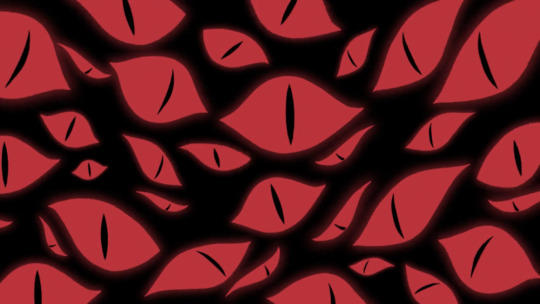
So, aside from the imagery of a black branching root or tree or hand something reaching and clawing around the world, we're guessing that the red eyes seen all over Hell symbolize Eve/Roo's influence--and are also probably partly the essence of Exorcized souls-- so, since we've got an idea of what She/They/It? take form as, what do you think would be possible protection against the Root of All Evil?
Easy, what's one of the opposite colors of red, that would likely represent Heaven? Blue. What's a charm that does exactly the job of protecting against "evil eyes"? We've actually got something for those, the TMA (The Magnus Archives) fandom might be familiar with it- because I'm totally not thefting[fondly] the idea from one of the fanfics, A Break in the Clouds, which has it be used to protect against The Beholding-
If the whole of religion and culture is to be seen as our oyster for theorycrafting, I propose that a good contender to oppose Roo, possibly even represent Hazbin Hotel's God him/themself, would be
The Nazar
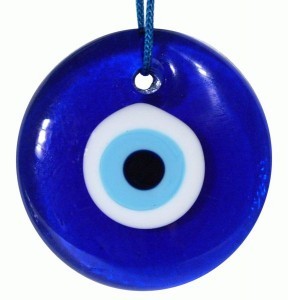
or, Eye Beads

Evil eye - Wikipedia
Okay so the "Evil Eye" - the belief in a malevolent look people can instill in one another, to curse or wish them harm- is a concept that's spread and brought about in like a lot of different cultures. Usually a thing borne out of jealousy and ill will- [envy], or just general ill will- it's an interesting thing that for many of the cultures the charms that were made against the such evil tended to implement eye imagery and the color blue. [definitely the more popular kind- actually, this emoji 🧿 is the nazar!]
Anyways, basically just. That. Roo would be the Evil Eye in this case, and Her influence was felt on Earth enough that it became something known to have to protect against, inverting the red eyes a bit as repulsive measure.
Or maybe a living human had seen the Eyes of God--or been shown a nebula like uh the Helix Nebula maybe we call that as the Eye of God apparently-- and then thought to take inspiration from the design.
Or maybe the plans would have been leaked to Earth from Hell, either being the work of Lucifer [because if anyone in Hell would know about the Root of Evil it would be him, plus potential angst at him having tried to help throughout history]
or from the Lust Ring [mostly because of the Blue, but also because of Love and Affection being the not-quite-opposite of Hate, and so would similarly have you pinned under gazes so different but equally strong],
or maybe even from Envy [because out of any Ring's people, they would be the ones to worry about the eyes the most, and so crack the code or at least create that superstition, painting imagery of evil eye protection]
Point is, I think that we might be able to use the evil-eye-protection stuff Evil Eyes [you know what I'll just call them Evil Eyes for simplicity, the charms usually get conflated with being called what they're protecting against anyways- or maybe they are supposed to symbolize the legit evil eye and it's like like magnets repulsive to each other, I dunno, I get confused- so calling them imagery or at least bastardized imagery in possible lore context might be okay too.] as protection against Roo.
It's not really a specific culture's thing, the Evil Eye concept, I am only slightly obsessed with Nazar and its variations. 🧿 : r/Witch (reddit.com), so it's a whole thing to dig into.
And also they can be used to represent God.

[also this would make this the safest Alastor to have ever been conceived] [place heaps of amulets on Alastor like leis, blue eyes litter his arms as corsages do or drawn on doodles- that man would despise how it ruins his color palette we gotta save him from the ordeal of being known/perceived but like the actual bad kind]
On a sidnote, if Roo and Hell[or Void?] are the naturally-occurring red eyes and God and Heaven are man-made [read: actively made with effort and trying] blue eyes, do you think they'd fight over dominion over Googly Eyes?
Or maybe it'll be funnier if that's purgatory's thing.

👀
27 notes
·
View notes